Skoda Kushaq: what is it?
It’s the first model born under ‘India 2.0’, the reboot of Skoda’s operations in India with which the Czech car maker (and the VW Group) hopes to establish a sustainable and profitable business. With 93% local content the Skoda Kushaq is also the first of a series of highly localised products designed and developed for Indian tastes, requirements and, most importantly, pockets. And to fit products into the Indian car buyer’s pocket, possibly the smallest in the world, has historically been the biggest stumbling block for global carmakers. Skoda, with a legacy of great cars like the Fabia and Yeti that failed solely because of price, knows this only too well. Which is why the company set itself some brutal cost targets to be price competitive, especially against the Korean brands which have all but taped up the midsize SUV segment.
To keep a tight lid on costs, Skoda had to develop and build the Kushaq with a large percentage of locally sourced parts (to avoid hefty import duties) but at the same instance, the company's engineers have cleverly cherry picked the best components from the VW Group’s global parts bin.
The Kushaq’s foundation is the Volkswagen Group's venerable and proven MQB-A0 platform, which has underpinned millions of compact VW Group models around the world. Called the MQB-A0-IN the Indian derivative platform thus has a robust and highly stiff chassis and a brilliantly engineered suspension system that promise class-leading dynamics.
Under the hood, you have the secret sauce, a pair of direct-injection, turbo-petrol or TSI engines. The base 1.0 TSI is locally produced in India and comes with a 6-speed manual and 6-speed torque converter, while the 1.5 TSI gets a 6-speed manual and a 7-speed DSG or twin-clutch automatic.
But even these much-acclaimed underpinnings are no guarantee of success, especially in an age where the battle has moved into the cabins. That’s where the Koreans are at their formidable best and hence, to compete, Skoda has thrown everything it can into the Kushaq, which will come in three trim variants – Active, Ambition and Style. There’s no stinting on safety and the top-spec Style variant gets six airbags and a host of active safety features like EBC, Multi Collision Braking, a Tyre Pressure Monitoring system (TPMS), brake assist, traction control and an electronic differential lock. All variants get Electronic Stability Control (ESC), in addition to the mandatory ABS.
We extensively drove the automatic and manual transmissions of both engine variants, (all with Style specification) to tell if you Skoda’s all-new mid-size SUV is on the button.
Skoda Kushaq: design
There's no holding back on the design which is very Skoda. The tightly skinned body is replete with cuts and creases, while the headlights, with their crystalline elements and LED strips, peel back nicely from the unmissable Skoda signature grille. It’s when viewed from the front that the Kushaq looks best and even bigger than it is.
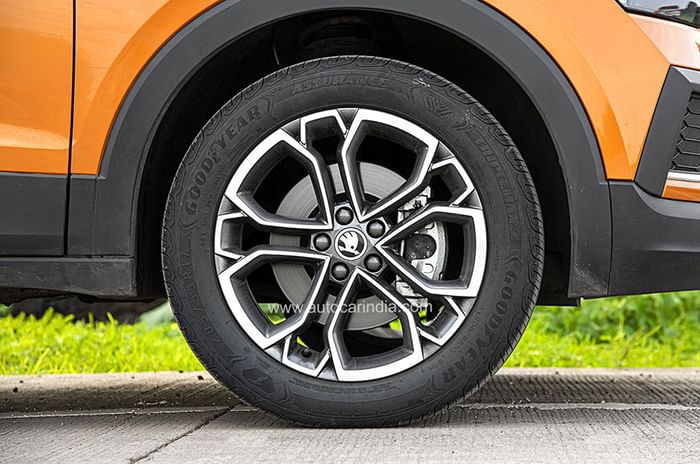
The fact is that the 4.2 metre-long Kushaq isn’t the largest SUV in its class but it has the longest wheelbase (2,651mm), which, along with short overhangs, gives it the right proportions and a purposeful stance. The 17-inch ‘Atlas’ alloys look stunning and very European, while liberal doses of chrome all-round give it the Indian flavour, Skoda has worked hard to serve up.
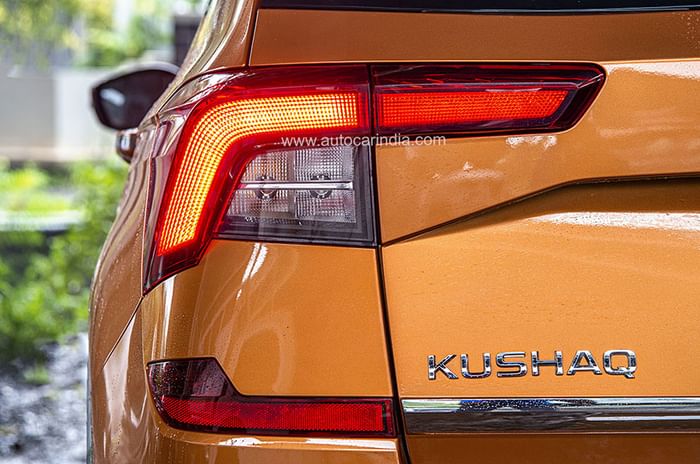
Skoda has also raised the Kushaq at the rear, so the roof is flat and not arched, and the SUV-like upright 'C' pillar, with the chrome accent, again hits the spot. The rear isn't as impressive as the front, but the three-dimensional tail-lights, with their crystalline structure, do catch your eye. If there is a drawback it’s that the taut and tightly skinned body optically looks a size down.
Skoda Kushaq: interiors
Skoda's cool-looking, two-spoke steering wheel, with its floating hub and neat chrome roller controls, feels nice and chunky to grip and is similar to what you get in the latest international Skodas. In fact, the beautifully crafted wheel is the only thing that feels European in an otherwise Indianised cabin.
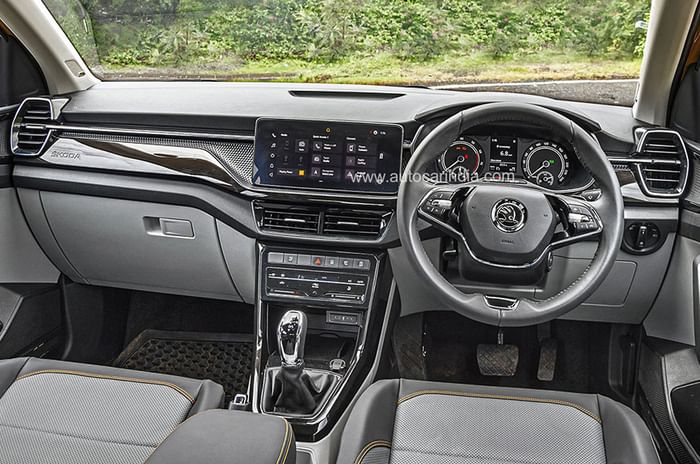
The Kushaq's designed-for-India dashboard has clean, horizontal lines, with some interesting three-dimensional elements that spice it up nicely. The hexagonal chrome-lined vents pop out nicely, while the multi-layered and multi-textured strip that runs across the dash lends some depth. The overall cabin design is clean and functional, and the light materials give it an airy feel, the doors also close with a satisfying thunk, but it’s when you start poking around the cabin that you quickly realise where Skoda has used the knife. While the dashboard top looks reasonably premium, the rest of the plastics fall short of the class standards set by the Kia Seltos. Details like the air vents and grab handles, which aren’t damped, feel flimsy to operate, the woven roof liner looks downmarket, there’s no shroud to hide the sunroof mechanism when you pull back the blind, and the leatherette seat fabric finished in grey with yellow piping isn’t evenly stitched. Nitpicking? Perhaps. But when you’ve been spoiled by Skoda’s legendary build quality and attention to detail, expectations run high.
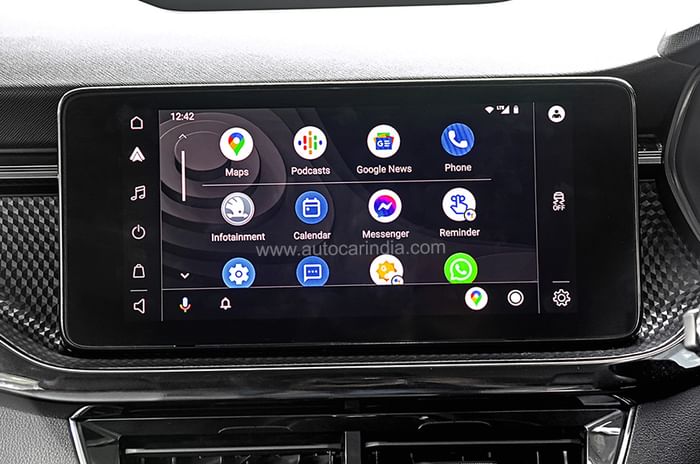
It appears that Skoda has sacrificed the small things to concentrate on the big items, the ones that customers really care about. This leads us to the all-important infotainment system which sports a high-resolution, 10-inch screen with sharp and easy to read graphics. It has the works like Apple Car Play, Android Auto and a host of Skoda Play apps like Gaana and Audiobooks that comes pre-installed. You don’t get remote start, but you can capture all sorts of real-time data, you can track your car, and there’s a valet mode you can set limits on. The screen is fairly responsive and intuitive to use and the way the icons are designed and laid out looks very contemporary. That can’t be said of the outdated instrument panel with its analogue dials that flank a low-resolution, black and white information screen. Skoda says a full-digital instrument cluster will come on the higher Monte Carlo variant, but we’ll have to till next year for that.
Special mention must be made of the touch-sensitive controls for the air-con, which, unlike a screen-operated slider, are nearly as intuitive to use on the move as a knob or button. This is literally a great touch!
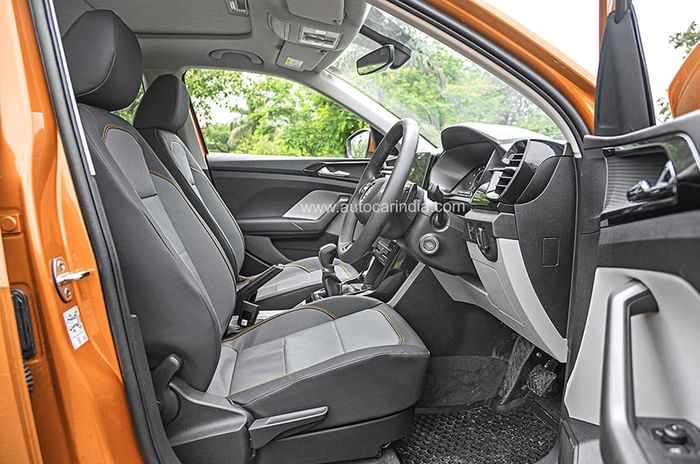
The seats too are well designed with the right level of firmness, and comfort is of a high order in the spacious cabin. The front seats offer lots of under-thigh support and generous bolstering. The perfect placement of the pedals and an adjustable steering, which comes right to you, makes it easy to find your ideal driving position. The front seats aren’t powered but are cooled in line with class standards, and this enhances comfort even further.
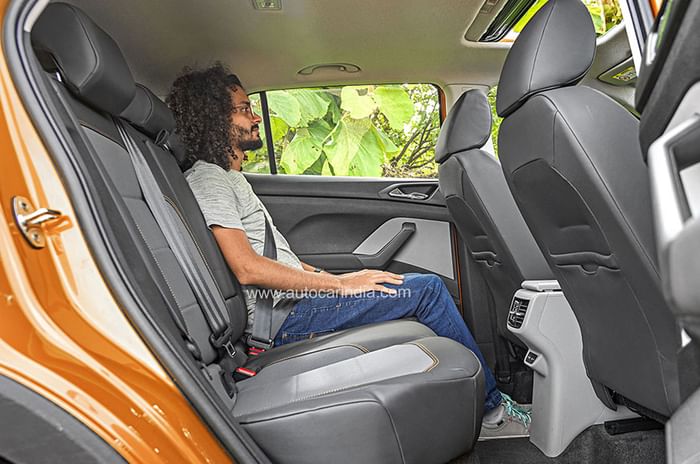
At the rear, the benefit of a long wheelbase is most evident, with the best-in-class legroom. Six-footers will have no problem stretching out, and headroom won’t be a problem either, since the roof is smartly scooped out at the rear. Again, under-thigh support is good and the backrest is perfectly angled, which further enhances comfort, especially on long drives. But the Kushaq is not particularly wide at the rear, so sitting three abreast isn’t advisable, though the absence of a high central hump does make it a bit easier for the middle passenger. Rear air con vents are standard and you get a pair of USB-C ports.
The cabin also has a generous amount of stowage space. The large glovebox and big door pockets hold a fair amount, you also get a squarish elbow box and a pair of cupholders; the latter capable of holding a bottle in place while you twist the cap open with one hand. There's a wide rubberised tray with a wireless charging pad,and at the rear, small pockets for your phone are stitched into the seat-backs.

The boot, at 385 litres, is around 50 litres less than the competition, and the loading lip is high, but four cabin bags will easily fit here, which is good enough for a weekend getaway. The seats also split 60:40 and with the rear bench folded, luggage space goes up to a huge 1,405 litres and ‘simply clever’ bits like nets and hooks are useful for fastening your luggage.
While the equipment list has all the usual bits as well as a few nice-to-have ones like cooled seats and wireless Android Auto and Apple Car Play, there’s still a fair bit missing when compared to rivals. It doesn’t get a powered driver’s seat, a panoramic sunroof, electric parking brake, 360 degree camera, a premium ‘branded’ sound system, head-up display, a full connected car experience or multiple drive modes. But drive is what the Kushaq does well. Really well.
Skoda Kushaq: performance
The 1.5 litre TSI engine is the most powerful one in its class, with 150hp and 250Nm of torque. And mated to a quick-shifting 7-speed twin-clutch DSG, the Kushaq 1.5 is also the fastest. It sprints to 100kph from rest in just 9.54sec, making it marginally faster than the Creta and the Seltos. You can feel the extra urge as soon as flex your right foot . It takes off smoothly from rest, acceleration is strong from the get-go, and the snappy upshifts stitch together an almost uninterrupted surge of power. The VW DSG is truly impressive, but it could be a touch slicker. When you want a quick burst of power after slowing down, the DSG hesitates a bit and there’s a jump in engine revs before the clutch fully engages. The 1.5 engine is smooth and loves to be revved but it gets a bit noisy at the redline which has more to do with the overall sound insulation of the car (there’s no under-bonnet sound shield), which could have been better. In fact, road noise on a coarse surface is something you have to ignore and there's a fair amount of wind noise at speed too.
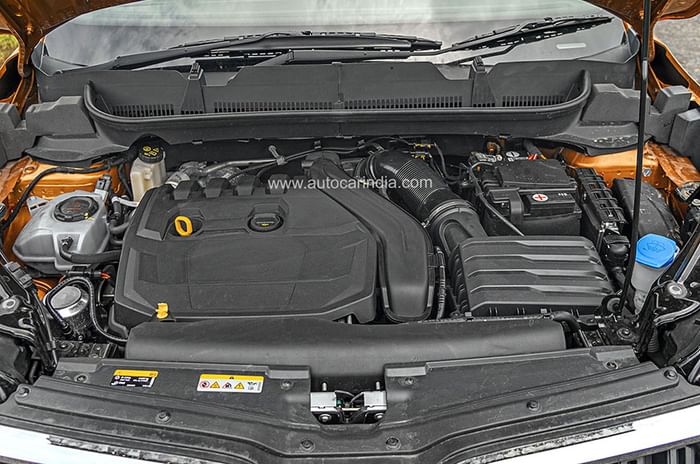
Where VW hasn’t cut corners is with the tech. Paddle shifters are standard with both engine options and the 1.5 comes with cylinder deactivation, where two cylinders are completely shut down in the interest of fuel efficiency. Turbo-petrol engines characteristically have wildly fluctuating efficiency and are sensitive to driving style, and while the official fuel efficiency figures of the Kushaq haven’t been revealed, we expect both engines to be fairly efficient, if driven with restraint.
Hardcore drivers who prefer three pedals can have the 1.5 TSI with a 6-speed manual, which is clearly the sportiest option. The gearshift is fairly smooth, and though the throws are a touch long, you can slot gears pretty quickly. The clutch bite point is a bit high up in the travel and a touch snappy, so this takes some getting used to. But it’s with the manual that you get to truly exploit the lusty power delivery of the 1.5 TSI, which comes in as low as 1,200rpm. This engine has a broad torque spread, and once you’ve got past the initial turbo lag, the power delivery is very linear. The relatively tall gearing goads you to wind the engine nice and hard, and as a highway cruiser, this variant of the Kushaq is hard to beat. While raw performance figures aren’t quite as good as the DSG, driving the manual with a press on driving style does deliver a lot, in terms driving pleasure.
You don’t expect the 1.0 TSI which produces 115hp and 178Nm of torque to deliver the same level of performance as the 1.5 and of course it doesn’t but in the context of its pint-size, this brilliant little three-pot motor punches above its weight. Way above. Firstly, it’s hard to tell this is a three-cylinder motor and apart from a mild rocking at idle, this engine is smooth, buzzy and free-revving.
There is some amount of turbo lag below 1,800rpm, which you encounter in traffic when you let the revs drop, but a downshift gets the engine back on the boil, and once you cross 2,000rpm, the Kushaq takes off with a surprising amount of gusto, with no let up till way past 6,000rpm. Acceleration is so strong, the engine feels considerably larger in capacity than its 1.0-litre size suggests. Again, it’s the broad spread of torque that makes the 1.0 Kushaq easy to drive. You don’t have to work the 6-speed manual gearbox hard and the sheer pulling power of this motor left us astonished. In fact, it feels faster than the 11.47 seconds it took get to 100kph. Performance could have been better if it were not for the tall gearing, which again has been arrived at in the interests of economy. Interestingly, there’s quite a gap between second and third gear ratios on both, the 1.0 and 1.5 manuals, with third gear being particularly tall. Hence, in traffic or when powering up a twisty mountain road, you do end up dropping quite frequently from third to second.
The biggest surprise was the 1.0 TSI with the 6-speed automatic. It wasn’t a surprise actually because this Aisin-sourced automatic merely confirmed what we’ve felt all along. That torque converters are so much better suited for daily driving in Indian conditions than twin-clutch ‘boxes and this point was driven home by the stark contrast between the 1.0 AT and 1.5 DSG. The 1.0 AT smartly step offs from a standstill and smoothly inches forward in stop-start traffic. It has a strong creep function, maybe a bit too strong, but it can be nicely modulated with the brakes. Flex your foot and there’s a bit of hesitation before the turbo starts spooling, after which the engine’s strong mid-range takes over. What the torque converter does successfully is mask the turbo-lag. It clearly isn’t as quick on the draw as a more modern twin-clutch unit, and you do need to shift to ‘S’ if want to hurry it up or reach for the paddles for full manual control.
That said, this gearbox isn’t one for spirited driving. Upshifts are quite leisurely and the dash to 100kph comes in a correspondingly relaxed 13 seconds. It’s just that the combination of this gearbox and engine work so well together, the whole here is clearly greater than the sum of parts.
| Skoda Kushaq performance | ||||
|---|---|---|---|---|
| 1.0TSI MT | 1.0TSI AT | 1.5TSI MT | 1.5TSI AT | |
| 20kph | 1.67s | 1.08s | 1.53s | 1.47s |
| 40kph | 3.07s | 2.59s | 2.72s | 2.78s |
| 60kph | 5.29s | 5.06s | 4.51s | 4.55s |
| 80kph | 7.83s | 8.23s | 6.52s | 6.86s |
| 100kph | 11.47s | 13.16s | 9.57s | 9.54s |
| 120kph | 15.93s | 18.40s | 12.89s | 13.26s |
| 140kph | 23.06s | 26.48s | NA | 18.09s |
| 20-80kph (3rd gear/kickdown) | 12.46s | 7.35s | 9.45s | 5.66s |
| 40-100kph (4th gear/kickdown) | 14.65s | 9.65s | 10.65s | 6.75s |
Skoda Kushaq: ride, handling and refinement
Where the Kushaq really aces it, and blows away its rivals, is in the ride and handling department. The stiff MQB chassis and a well-judged suspension setup have laid the groundwork for brilliant dynamics, which neither the Seltos nor the Creta can hold a candle to. The only thing that comes close in some areas is the forgotten Duster.
The steering, too, is brilliant and perfectly calibrated for the job, which is to please a typical Kushaq owner. It’s nice and light, which is what owners will want most of the time, but the lack of heft hasn’t come at the expense of feel. The steering is quick off-centre and loaded with feedback, which gives you immense confidence through corners and at high speeds. In fact, another area where the Kushaq excels is on the highway. High-speed stability is top class, the ride is utterly composed and on bumpy or uneven surfaces, the Kushaq’s rock-solid composure is genuinely mind boggling. Deep ruts, big potholes and generally ripped out sections pose no challenge, it just takes them in its stride. Ride quality in general is also excellent, despite the underlying layer of stiffness. It isn't the most supple setup around but it’s the way the Kushaq rounds off ruts and sharp edges, which a Creta or Seltos would crash through, that highlights how finely tuned the suspension is. The brakes too inspire confidence and the Kushaq has sufficient stopping power, despite having drums at the rear.
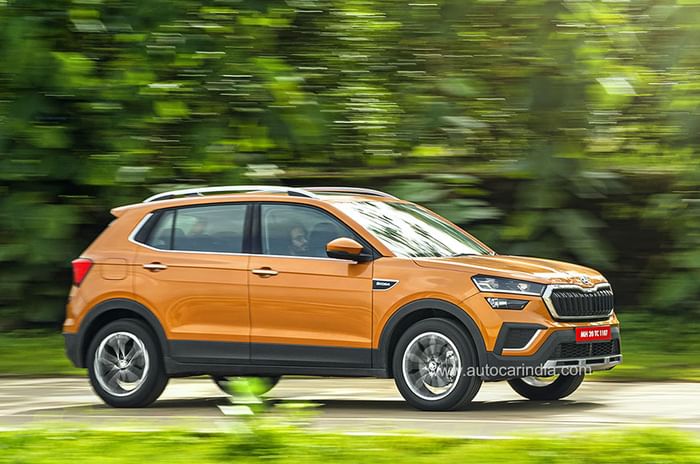
In terms of handling, it’s the lighter 1.0 that turns into corners with more verve and feels the more agile of the two. On a twisty road, the 1.0 feels a touch more balanced than the 1.5, which has more weight in its nose. However, both cars are simply great to drive and give a special joy, the kind you only get from a great chassis married to strong engines. Now, if only there was a strong diesel in the mix.
Skoda Kushaq: first verdict
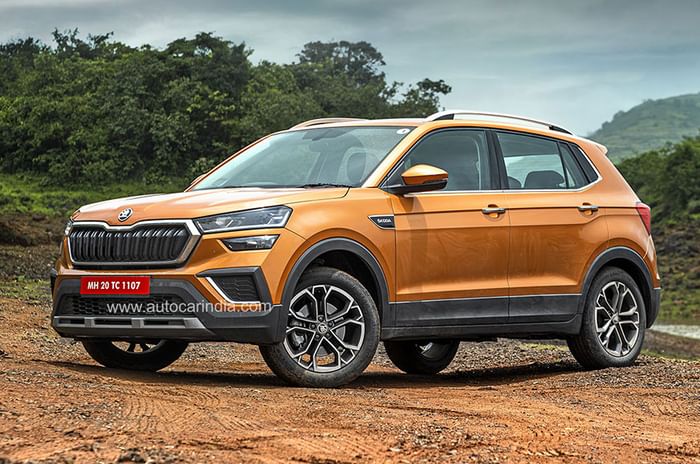
Skoda's Kushaq gets a lot of things right, straight off the bat. It looks great (though a tad small) has a strong set of engines and a good suite of safety features. It’s also comfortable and easy to live with and what sets it apart is that it is way more enjoyable to drive than any other mid-size SUV.
But then, this isn’t a car you’d buy just for equipment and creature comforts. If performance, sound driving dynamics and safety top your list, the Kushaq is definitely the way to go.





































